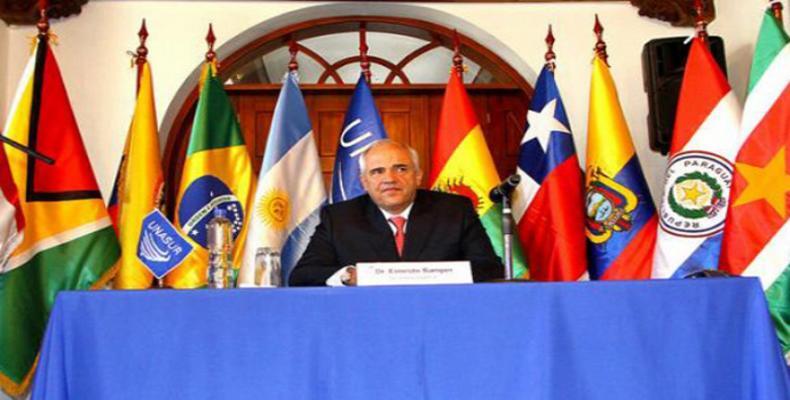Simon Bolivar was the first prominent Latin American leader to seek integration among the newly-formed Latin American nations. He joined Colombia, including Panama, Ecuador and Venezuela in what became known as Gran Colombia. Bolivar also led the movement to organize a multinational conference Panama in 1826. The goal of the gathering was to create a federation of independent states in alliance with Great Britain and as a counterweight to the United States’ Monroe Doctrine. Representatives from Guatemala, then encompassing most of Central America, Mexico, Gran Colombia and Peru attended, although Brazil and Argentina did not participate. Also invited were representatives from the British and Dutch governments.
The ultimate failure of the 1826 conference to establish a union of Latin American nations and the development of separate Latin American republics eventually led to a series of disputes within the region and greater economic dependence on Europe and the United States. That pattern did not change markedly throughout the 19th and first half of the 20th century.
The first successful multinational organization of Western Hemisphere states was the Pan American Union, created in 1890. This organization and its 1948 successor, the Organization of American States the OAS, were organized by the United States and largely followed the goals proposed by the United States. Only in the last few years did the countries OAS challenge this founding member, demanding participation by Cuba in the 2015 Summit of the Americas.
The legacy of Simon Bolivar, and the idea for a comprehensive regional organization outside the influence of the United States, had little sustained support until the ascension of Hugo Chávez to the presidency of Venezuela in 1999. Chávez called for a Bolivarian Revolution that sought to implement many of the goals originally espoused by Bolivar. Among them was the goal of regional integration.
Representatives at the 2004 South American Summit signed the Cuzco Declaration creating the South American Community of Nations that would ultimately become UNASUR. Chávez in turn proposed the creation of an alternative economic agreement, the Bolivarian Alternative for the Americas (ALBA). Its goal was create a more integrated region in ways that would benefit the people instead of corporations.
The Cuzco Declaration created an organization restricted to South American nations, which excluded the United States. The organization’s original name, South American Community of Nations, was changed in 2007 to the Union of South American Nations (UNASUR), highlighting the goal of regional integration socially, economically and politically. Its constitutive treaty was signed in 2008 and was ratified by all current member nations by 2010. It went into force on March 11th 2011. The late Nestor Kirchner, former president of Argentina, was elected its first Secretary General. UNASUR has a permanent secretariat in Quito, Ecuador and a Council of Heads of State that meets yearly.
UNASUR immediately demonstrated its significance during the Colombian-Venezuelan diplomatic crisis in 2010. UNASUR arranged for a meeting of Chávez with the newly-elected Colombian president, Juan Manuel Santos and tensions were reduced. Both Colombia and Venezuela are members of the OAS, where such issues are routinely debated. U.S. opposition to the Venezuelan regime initially made it harder for the OAS to take effective action. Instead, UNASUR, without the divisive presence of the United States, was able to intervene to help reduce tension in the region.
There is now another border crisis between Colombia and Venezuela. Then, in late August, Venezuelan president Nicolás Maduro closed the border after Venezuelan soldiers were wounded by Colombian smugglers. In addition, more than one thousand Colombians living on the Venezuelan side of the impacted border area without proper documentation were deported. Both governments recalled their ambassadors for consultations as tensions rose.
Ernesto Samper, current Secretary General of UNASUR offered to sponsor a meeting of the presidents of Colombia and Venezuela to help resolve the crisis. Colombian President Juan Manuel Santos and his Venezuelan counterpart Nicolas Maduro agreed on Monday in Quito to re-open their embassies in an attempt to ease tensions over an ongoing border crisis.
Santos and Maduro “committed themselves to formulate a deal that will solve the problems at the joint border, focusing on brotherly coexistence, mutual respect, and the social and economic development,” Ecuadorean President Rafael Correa read from a joint statement after the meeting.
Both presidents also vowed to allow the return of their ambassadors and create bilateral committees to address the border situation, said Correa.
These two recent crises demonstrate that the potential role of UNASUR as a regional organization can be more effective than the OAS. The goal of UNASUR is to create a regional block of nations integrated in ways that reduce tensions within South America and strengthen the region with regard to the United States and other powerful nations.
Bolivar’s dream of a United States of South America is far from being achieved, and none of the member states of UNASUR contemplate surrendering sovereignty. Nevertheless, UNASUR is providing the necessary framework for conflict resolution, cooperation and promoting common goals among its member nations.


